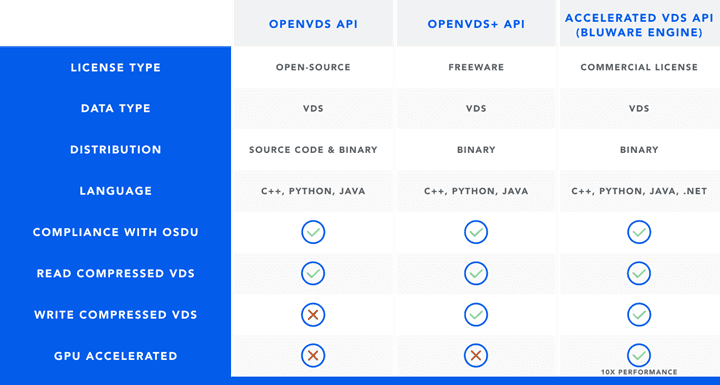Morten Ofstad, Chief Architect at Bluware
Stream seismic data directly to your applications and to accelerate and improve visualization, while eliminating data duplication.
In a world moving toward cloud-native solutions to make data more accessible, scalable, and secure, data managers and IT teams shouldn’t let their geoscience teams be held back by legacy seismic data formats to conduct their subsurface workflows.
Traditional seismic data formats and workflows are outdated, causing:
- Data duplication
- Challenges in collaboration
- Slow data load time
- Inefficient data management
- Data degradation
- Costly storage
Data managers feel frustrated by the slow and cumbersome process of handling large seismic data files that slow down decision-making, while IT professionals are frustrated with the strain on resources, unpredictable storage costs, and data duplication.
In an era where efficient data storage and accessibility are vital, Bluware’s Volume Data Store (VDS™) has emerged as a game-changing solution for managing multi-dimensional signal data, particularly in seismic applications.
What is VDS?
The Bluware VDS format revolutionizes data management in the oil and gas industry by addressing the critical limitations of traditional storage systems. Over 15 years of innovation have resulted in a flexible, performance-oriented architecture designed to optimize workflows and unlock new possibilities.
With VDS, operational efficiency is dramatically improved through reduced data loading times, enabling near-instant access to large seismic datasets and enhanced real-time visualization. This empowers geoscientists to interpret data faster and make more informed decisions, driving productivity and accelerating project timelines.
VDS: Tailored Storage for Every Environment
The format can be deployed either on object store, on a traditional file system, or in a hybrid environment.
Supports Multiple E&P Data Types
- Seismic lines
- Regularized single-z horizons/height-maps
- Attribute volumes up to 6D
- Pre-stack volumes
- Post-stack volumes
- Geo-body volumes
Unlike traditional seismic data formats, which require significant storage and processing power, VDS allows large volumes of seismic data to be streamed efficiently to a user’s application, making it accessible in real-time. VDS eliminates the need to copy and convert data to different formats by only serving the required signal quality to the workflow, yielding extremely fast data access.
VDS streamlines workflows for geoscientists and optimizes data handling and storage for data managers and IT, helping all teams work more efficiently and cost-effectively in cloud-based environments.
VDS Solves Geoscience Data Management Challenges
- A Format for Centralizing Storage: VDS reduces data duplication and conversion by storing seismic data in an optimized, centralized format.
- Interoperability with Existing Applications: VDS can be accessed through GPU-optimized Bluware SDK and OpenVDS and through Bluware FAST without changing your consuming application.
- Real-Time Access and Interpretation: VDS enables rapid adaptive data streaming, allowing geoscientists to access only the data they need at any given time, removing delays, accelerating workflows, and reducing interpretation cycle times.
- Highest-Quality Visualization: VDS supports the highest possible data quality, avoiding the degradation seen in traditional formats and ensuring geoscientists work with the best possible data.
- Configurable Options: Users can optimize for precision, performance, or storage space based on their requirements.
- Seamless Cloud Integration: VDS supports cloud-native workflows, which allows teams to collaborate remotely and securely while leveraging the computational power of the cloud for AI-driven interpretation, reducing dependency on local infrastructure.
VDS Solves IT Challenges
- Format Flexibility: Data can be freely converted back to its original format, eliminating vendor lock-in concerns
- Data Storage Optimization: VDS’s compression capabilities reduce the need for heavy storage solutions since data is stored in a more optimized format, saving costs on storage.
- Reduced Data Transfer and Load Times: VDS minimizes the amount of data that needs to be transferred and accessed, which reduces latency and bandwidth costs, making data more manageable.
- Easy Cloud Migration: VDS facilitates the secure transfer of seismic data from legacy formats like SEGY to VDS, making it easier to manage, archive, and access data in cloud environments without risking data integrity or accessibility.
- Low CapEx Scalability – Use VDS in your distributed compute workflows and scale compute power through your cloud provider as needed rather than owning and managing hardware yourself.
VDS – An Industry Standard
In a significant move toward industry standardization, Bluware has contributed the OpenVDS specification to The Open Group OSDU™ Data Platform. This open-source initiative demonstrates Bluware’s commitment to transparency and interoperability in the seismic data industry. Access Volume Data Store (VDS) Specification documentation here and VDS Deep Dive documentation which contains more details.
VDS Implementations
There are three main SDK options for developers:
OpenVDS: An open source API to access VDS, available on The Open Group OSDU™ Data Platform.
OpenVDS+: A free, binary distribution of OpenVDS and adds the ability to compress VDS using Bluware’s industry leading compression technology.
Bluware Engine: The commercial offering featuring wavelet data compression and GPU-accelerated decompression which enables as much as 10x accelerated VDS data performance in your geoscience workflows through Bluware’s commercial tools or deployed in your custom software solutions.

VDS represents a significant advancement in seismic data storage, offering a balanced approach between commercial capabilities and open-source accessibility. For data managers and IT enabling geoscientists to run compute-intensive workflows in the cloud or on-premises, VDS provides a flexible, cost-efficient solution to address your current seismic data performance and challenges.
